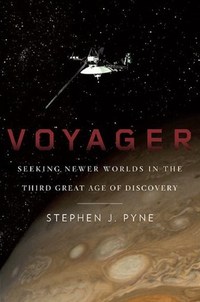Review: Voyagerby Jeff Foust
|
| “What is lost” in this new era of exploration, he writes, “is the inherited sense that exploration must be done by human explorers on the scene and the human drama that goes with flawed human actors.” |
In the book, and in an excerpt from it published here last month (see “Space travel as exploration”, The Space Review, August 2, 2010), Pyne, a professor at Arizona State University, argues that we are in a third era of exploration, after an initial wave of exploration from the mid-fifteenth to the early eighteenth centuries and a second wave from the late eighteenth through the early twentieth centuries. This third wave, he argues, is distinguished by the fact that it explores places where there are no native humans—Antarctica, the seafloor, and deep space—and because such exploration does not require the direct participation of humans, as Voyager and other robotic space missions have demonstrated.
Pyne’s book is not a detailed history of the Voyager missions, although he does examine the project’s development from initial concepts for a “Grand Tour” of the outer solar system that would take advantage of a fortuitous alignment of planetary gravitational assists, to the development, launch, and operation of the two spacecraft that would make their way past Jupiter and Saturn and, in the case of Voyager 2, Uranus and Neptune. Instead, he uses the missions as a framework to examine these concepts of exploration, comparing and contrasting Voyager with past voyages of exploration on Earth. Voyager, he argues, ranks up there among the most influential journeys of exploration in human history, a “grand gesture” of this third era of exploration.
Much of the interest people have in the history of exploration, of course, is linked to a search for insight into the future of exploration, particularly given the muddled state of NASA’s future plans for human spaceflight in particular. “What is lost” in this new era of exploration, he writes, “is the inherited sense that exploration must be done by human explorers on the scene and the human drama that goes with flawed human actors.” That is the case not just in spaceflight, but also in undersea exploration, where robotic submersibles are now becoming dominant. (However promising undersea exploration is in this third era, he notes, it has not captured public attention in the same way space exploration has; in part, he argues, not because of the lack of a human presence but because it has not had its equivalent of Voyager.)
Voyager, many would argue, was the apex of a “golden era” of planetary exploration, one that has since come to an end. Pyne notes that during the height of the Voyager missions, Bruce Murray, then the director of JPL, came to the realization that the rapid pace of discovery of the first two decades of the Space Age could not be sustained; we would not be able to keep it up to continue exploration of, and beyond, our solar system. “There would be a falloff,” Pyne writes, “which he found both depressing and impossible to stop.” Fortunately, after the long gaps in the 1980s where there were no NASA planetary science missions, that effort has been restored with a steady state of missions that continue to explore the solar system, from MESSENGER’s journey to Mercury to New Horizon’s voyage to Pluto. “These are brilliant, successful missions,” he writes, “but they necessarily lack the zest of the vision quest and the drama of first-time encounter.” Or, as one Voyager team member put it, “You only the discover the solar system for the first time once.” Voyager the book helps put that discovery, and exploration, into a broader historical context.
